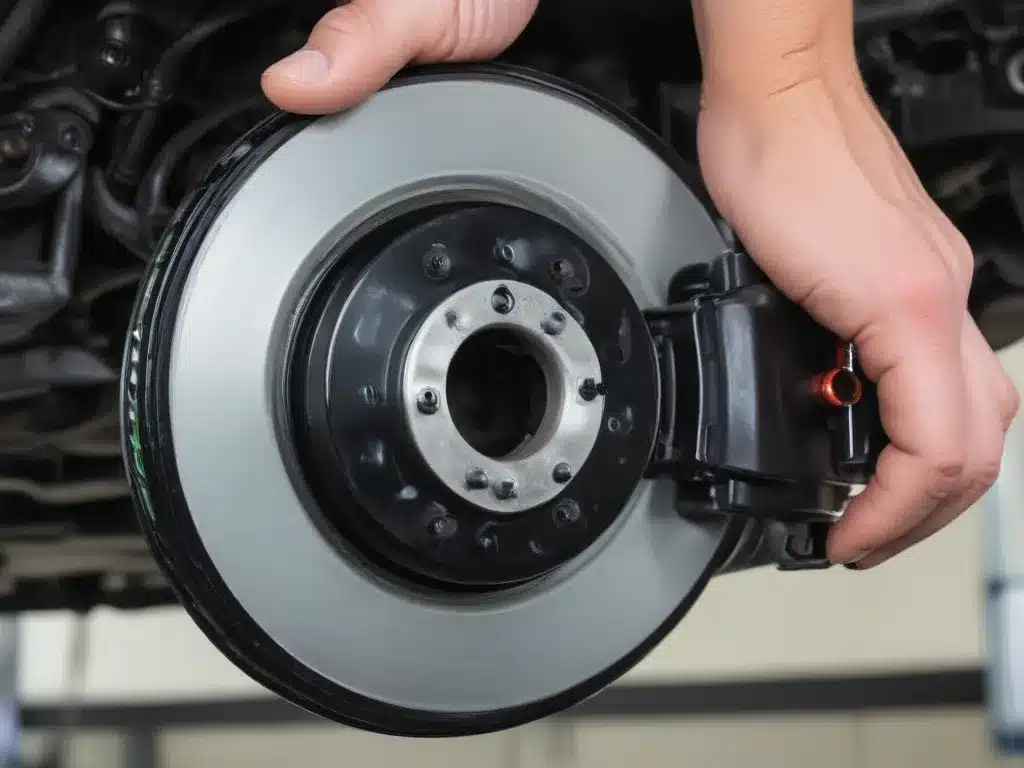
Understanding the Importance of Brake Fluid
As a car enthusiast, I can’t stress enough the importance of maintaining your vehicle’s brake system. It’s the one thing that keeps you safe on the road, so it’s crucial to ensure it’s in tip-top shape. And you know what that means? Keeping a close eye on your brake fluid.
You might be thinking, “Brake fluid? Isn’t that just some mysterious liquid that I top up every now and then?” Well, my friend, there’s a lot more to it than that. Brake fluid is the lifeblood of your braking system, and it plays a vital role in ensuring your car can come to a safe, controlled stop.
You see, brake fluid is what transmits the force from your foot on the brake pedal to the brake pads, which then grip the rotors and slow down your vehicle. Without proper brake fluid, your brakes simply won’t work as they should. And trust me, you don’t want to find that out the hard way.
The Lowdown on Brake Fluid Types
Now, when it comes to brake fluid, there are a few different types out there, and they’re not all created equal. The most common types are DOT 3, DOT 4, and DOT 5.1. Each one has its own unique properties and characteristics, and it’s important to know which one your vehicle requires.
DOT 3 brake fluid is the most basic of the bunch, with a lower boiling point and a tendency to absorb moisture over time. DOT 4, on the other hand, is a bit more advanced, with a higher boiling point and better moisture resistance. And then there’s DOT 5.1, which is the cream of the crop – it has an even higher boiling point and is less susceptible to moisture absorption.
So, which one should you use? Well, that depends on your vehicle’s specifications. Some cars are designed to work with DOT 3, while others require DOT 4 or DOT 5.1. It’s crucial that you check your owner’s manual or consult with a trusted mechanic to make sure you’re using the right brake fluid for your ride.
Recognizing the Signs of Brake Fluid Issues
Now, even if you’re using the correct brake fluid, that doesn’t mean you’re out of the woods. Over time, brake fluid can break down and become contaminated, which can lead to some serious problems.
One of the first signs of trouble is a spongy or soft brake pedal. This could be an indication that your brake fluid is low or that it’s become contaminated with moisture. Another red flag is if your brakes start to feel less responsive or if you notice a longer stopping distance.
And let’s not forget about the visual cues. If your brake fluid looks dirty or discolored, that’s a clear sign that it’s time for a change. It should be a nice, clear golden color. If it’s murky or has a brownish tint, it’s time to flush that system and start fresh.
Maintaining Your Brake Fluid for Peak Performance
So, what’s the solution? Well, the key is to stay on top of your brake fluid maintenance. Most manufacturers recommend flushing and replacing your brake fluid every two to three years, or whenever you start to notice any of the warning signs we discussed.
When it comes to the actual process, it’s best to leave it to the professionals. Brake fluid flush and replacement is a bit more involved than your typical oil change, and it’s crucial that it’s done properly to ensure the safety and reliability of your braking system.
During the process, your mechanic will drain the old fluid, flush the system to remove any contaminants, and then refill it with the appropriate type of fresh brake fluid. They’ll also check for any leaks or other issues that could be affecting your brakes.
The Importance of Regular Brake Fluid Maintenance
I know, I know, brake fluid maintenance might not be the most exciting part of car ownership. But trust me, it’s one of the most important. Neglecting your brake fluid can lead to some seriously dangerous situations on the road.
Imagine you’re driving down the highway, merging to pass a semi-truck, and you press the brake pedal only to find that it goes straight to the floor. That’s a nightmare scenario that no one wants to find themselves in. But it’s exactly what can happen if your brake fluid is old, contaminated, or low.
And let’s not forget about the financial implications. Letting your brake fluid maintenance slide can end up costing you big time down the line. Neglected brake fluid can lead to premature wear on your brake components, which means expensive repairs or even a full system replacement.
So, my advice? Don’t wait until it’s too late. Stay on top of your brake fluid maintenance, and make sure you’re using the right type of fluid for your vehicle. It’s a small investment that can pay huge dividends when it comes to your safety and the longevity of your car.
Wrapping Up: The Importance of Brake Fluid
At the end of the day, brake fluid might not be the most glamorous part of car ownership, but it’s undoubtedly one of the most important. It’s the unsung hero that keeps your brakes functioning properly and ensures your safety on the road.
So, the next time you’re thinking about your car’s maintenance, don’t forget about that humble little bottle of brake fluid. Take the time to understand the different types, watch out for the warning signs of trouble, and make sure you’re getting it flushed and replaced on a regular basis.
Trust me, your future self (and your wallet) will thank you. Happy and safe driving, my friends!


